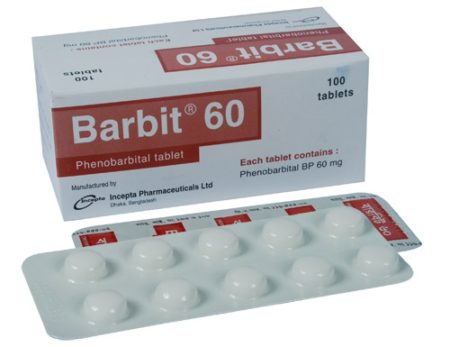
Type:10 Tablets
Generic Name:Phenobarbitone (Phenobarbital)
Manufacturer:Incepta Pharmaceuticals Ltd.
Price:৳15.00
Status epilepticus, Partial seizures, Sedation, Generalised tonic-clonic seizures, Hypnotic, Preoperative sedation
May be taken with or without food.
Oral Sedation Adult: 30-120 mg daily in 2-3 divided doses, do not exceed 400 mg/day Status epilepticus ; Emergency management of acute seizures Adult: 100-300 mg daily at bedtime. Generalised tonic-clonic seizures, Partial seizures Adult: 60-180 mg/day at night. Insomnia Adult: 100-200 mg daily at bedtime, do not exceed 400 mg/day As a hypnotic Adult: 100-320 mg. Do not admin for >2 wk for the treatment of insomnia. Elderly: Reduce dose. Hepatic impairment: Reduce dose. Severe: Contraindicated.
Oral Sedation Child: 2 mg/kg daily in 3 divided doses. Status epilepticus ; Emergency management of acute seizures Child: 3-5 mg/kg or 125 mg/m2 daily. Seizures Neonates (<28 days): 3-5 mg/kg/day in 1-2 divided doses Infants: 5-6 mg/kg/day in 1-2 divided doses 1-5 years: 6-8 mg/kg/day in 1-2 divided doses 6-12 years: 4-6 mg/kg/day in 1-2 divided doses >12 years: 1-3 mg/kg/day in 1-2 divided doses, OR 50-100 mg BID/TID Preoperative sedation Child: 1-3 mg/kg pre-op.
Renal impairment: Reduce dose. Severe: Contraindicated.
Severe renal and hepatic disorders. Severe respiratory depression, dyspnoea or airway obstruction; porphyria. Pregnancy.
Phenobarbitone is a short-acting barbiturate. It depresses the sensory cortex, reduces motor activity, changes cerebellar function, and produces drowsiness, sedation and hypnosis. Its anticonvulsant property is exhibited at high doses.
Patient w/ history or sedative/hypnotic addiction; resp disease, depression or suicidal tendencies, hypoadrenalism. Avoid abrupt withdrawal. Mild to moderate renal and hepatic impairment. Elderly or debilitated patient, childn. Pregnancy and lactation. Patient Counselling May impair ability to drive or operate machinery. Monitoring Parameters Monitor CBC, LFTs, mental status and seizure activity. Lactation: Do not nurse
Common Ataxia,Dizziness,Drowsiness,Dysarthria,Fatigue,Headache,Irritability,Nystagmus,Paresthesia restlessness,Vertigo Geriatric patients: Excitement, confusion, depression Pediatric patients: Paradoxical excitement/hyperactivity Less Common Mental dullness,Constipation,Diarrhea,Nausea,Vomiting,Megaloblastic (folate-deficiency) anemia Uncommon Rash,Hypocalcemia,Hepatotoxicity Rare Stevens-Johnson syndrome,Rickets,Osteomalacia Potentially Fatal: Stevens-Johnson syndrome.
May enhance the hepatotoxic potential of paracetemaol overdoses. May decrease levels/effects of various CYP isoenzyme substrates e.g. teniposide, methotrexate, antipsychotics, beta-blockers, calcium-channel blockers, other anticonvulsants, chloramphenicol, cimetidine, corticosteroids, ciclosporin, doxycycline, oestrogens, felbamate, griseofulvin, tacrolimus, furosemide, methadone, oral contraceptives, theophylline, TCAs, warfarin. May reduce effects of guanfacine. Reduced metabolism and or increased toxicity with chloramphenicol, felbamate, MAOIs, valproic acid. May enhance the nephrotoxic effects of methoxyflurane. Potentially Fatal: Additive sedation and/or respiratory depression with ethanol, sedatives, antidepressants, opioid analgesics, benzodiazepines and other CNS depressants. May decrease levels/effects of antiarrhythmic drugs e.g. disopyramide, propafenone, quinidine.